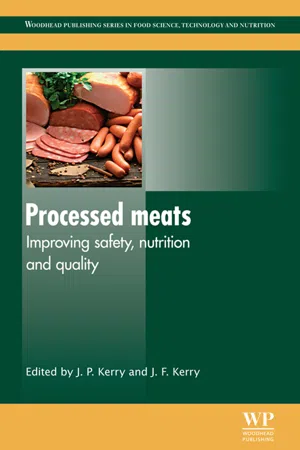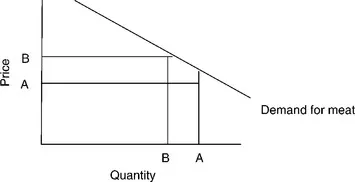
- 752 pages
- English
- ePUB (mobile friendly)
- Available on iOS & Android
eBook - ePub
About this book
In a market in which consumers demand nutritionally-balanced meat products, producing processed meats that fulfil their requirements and are safe to eat is not a simple task. Processed meats: Improving safety, nutrition and quality provides professionals with a wide-ranging guide to the market for processed meats, product development, ingredient options and processing technologies.
Part one explores consumer demands and trends, legislative issues, key aspects of food safety and the use of sensory science in product development, among other issues. Part two examines the role of ingredients, including blood by-products, hydrocolloids, and natural antimicrobials, as well as the formulation of products with reduced levels of salt and fat. Nutraceutical ingredients are also covered. Part three discusses meat products' processing, taking in the role of packaging and refrigeration alongside emerging areas such as high pressure processing and novel thermal technologies. Chapters on quality assessment and the quality of particular types of products are also included.
With its distinguished editors and team of expert contributors, Processed meats: Improving safety, nutrition and quality is a valuable reference tool for professionals working in the processed meat industry and academics studying processed meats.
- Provides professionals with a wide-ranging guide to the market for processed meats, product development, ingredient options, processing technologies and quality assessment
- Outlines the key issues in producing processed meat products that are nutritionally balanced, contain fewer ingredients, have excellent sensory characteristics and are safe to eat
- Discusses the use of nutraceutical ingredients in processed meat products and their effects on product quality, safety and acceptability
Frequently asked questions
Yes, you can cancel anytime from the Subscription tab in your account settings on the Perlego website. Your subscription will stay active until the end of your current billing period. Learn how to cancel your subscription.
At the moment all of our mobile-responsive ePub books are available to download via the app. Most of our PDFs are also available to download and we're working on making the final remaining ones downloadable now. Learn more here.
Perlego offers two plans: Essential and Complete
- Essential is ideal for learners and professionals who enjoy exploring a wide range of subjects. Access the Essential Library with 800,000+ trusted titles and best-sellers across business, personal growth, and the humanities. Includes unlimited reading time and Standard Read Aloud voice.
- Complete: Perfect for advanced learners and researchers needing full, unrestricted access. Unlock 1.4M+ books across hundreds of subjects, including academic and specialized titles. The Complete Plan also includes advanced features like Premium Read Aloud and Research Assistant.
We are an online textbook subscription service, where you can get access to an entire online library for less than the price of a single book per month. With over 1 million books across 1000+ topics, we’ve got you covered! Learn more here.
Look out for the read-aloud symbol on your next book to see if you can listen to it. The read-aloud tool reads text aloud for you, highlighting the text as it is being read. You can pause it, speed it up and slow it down. Learn more here.
Yes! You can use the Perlego app on both iOS or Android devices to read anytime, anywhere — even offline. Perfect for commutes or when you’re on the go.
Please note we cannot support devices running on iOS 13 and Android 7 or earlier. Learn more about using the app.
Please note we cannot support devices running on iOS 13 and Android 7 or earlier. Learn more about using the app.
Yes, you can access Processed Meats by Joseph P. Kerry,John F. Kerry in PDF and/or ePUB format, as well as other popular books in Technology & Engineering & Food Science. We have over one million books available in our catalogue for you to explore.
Information
Part I
Processed meats: market-driven changes, legislative issues and product development
1
Consumer demands and regional preferences for meat
L.B. Catlett, New Mexico State University, USA
Abstract:
Consumer preference for meat is examined via the determinates of demand. Price, income, cross and supply elasticity are discussed, explained and compared among various countries. Regional preferences for meat are explored and a comparison is given of developing and developed countries. General economic and demographic rules are listed as a way to forecast future meat consumption patterns.
Key words
price elasticity of demand
income elasticity
cross elasticity
supply elasticity
L-glutamate
Engel curve
1.1 Introduction
Humans, being omnivores, have constantly altered their diets throughout history. We know that societies that emerged close to lands suitable only for roaming animals had diets richer in meat than more sedate farming communities that were located in arable land areas. Families that settled either in the western United States or in central Australia over 100 years ago had diets dominated by mutton, lamb and beef compared with farming families in Ireland that consumed most of their calories via potatoes. Climate certainly has played a role in food consumption patterns but culture and technology likewise have had major influences. Spanish colonizers that settled in the southwest United States brought numerous species of farm animals with them in the 1500 s but as they settled in the river valleys they gradually adopted the culture of the Native Americans that farmed maize, legumes and chile peppers via irrigation. Climate, culture and technology helped form individual as well as group diets throughout much of the last 6000 years of recorded history. The generation born during the early 1900s that grew to maturity during the Great Depression and World War II did not live in a radically different way from the generation born in the early 1700 s. Their food consumption patterns were dominated by where they lived (climate), how they were raised (culture) and technology. During the 200 years from 1700 to 1900 climate and culture changed little and the only food technologies to have any impact on consumption patterns – canning and freezing – emerged late in the 1800 s. Thus you could predict with a large degree of certainty that if you grew up in urban New York City in either the early 1700 s or early 1900s your meat and food consumption patterns were not materially different. Likewise, farmers in rural France in the early 1700 s did not differ very much from their counterparts in the early 1900s in their meat consumption patterns which were set by the climate and culture.
Yet as economies have matured and science slowly emerged, two other forces altered how and what consumers want in their food during the last 100 years. The concepts of taste and choice have emerged to be major factors in consumer demand for food. As consumers began to express their individual taste differences, naturally more choices in processed meats have emerged. Pearson and Gillett (1999) reported 41 categories of fresh and frozen beef and pork not counting sausages which added another 24 choices just in the United States. This did not account for other types of meat (marine, poultry and other red meats) nor for other types of processing such as canning. To be sure the list has grown dramatically by adding categories such as aging, grass fed, free range and organic. Furthermore new cuts and flavorings make the list of choices for processed meats almost limitless.
1.2 The effect of taste on meat consumption
A couple of events happened almost simultaneously in opposite parts of the world in the early 1900s that altered meat consumption forever. Lehrer (2007) describes how Augusta Escoffier changed professional food preparation by developing meat stock as an addition to all foods, not just meat dishes. He carefully described his process of using meat bones and parts to make a stock and then deglaze the seared meat to extract the caramelized amino acids in his 1903 book Guide Culinaire. He changed not only French food but professional food preparation worldwide. Prior to Escoffier’s work, science said that the tongue can detect only four flavors – sweet, salty, bitter and sour. Escoffier knew that his stock or sauce added a flavor that humans could and did detect and it was none of the four flavors. Little did he know that he had stumbled upon the amino acid L-glutamate. Half way across the world from France, a Japanese chemist Kikunae Ikeda discovered the molecule glutamic acid in 1907. With cooking or fermentation glutamic acid forms L-glutamate – the fifth flavor (otherwise referred to as umami or savoriness) that the tongue can taste. Ikeda stabilized glutamic acid with salt and formed the famous monosodium glutamate (MSG). MSG became a chef’s secret way to add a new taste sensation without having to cook Escoffier’s stock for 12 hours. The rest, as they say, is history. In 2000 a tongue receptor was discovered that senses only glutamate and L-amino acids. Technology and science now gave consumers a way to understand and appreciate why they generally love the taste of meat and how that taste sensation can be added to other foods via L-glutamate.
1.3 The effect of choice on meat consumption
History has always recorded that the very wealthy can and do eat whatever they want and generally that has always included numerous forms of meat. Economic democracy is really a product of the twentieth century whereby the emergence of a middle class allowed humans to have a choice about what foods they wanted to consume. Certainly the salad years of the Roman Empire and Greece as well as isolated city-states at various times in history produced similar results for their citizens, but nothing rivals the emergence of the middle classes in the 1900s in changing food consumption patterns that were long dominated by climate and culture. After World War II more and more consumers changed their food consumption habits as they moved into middle class. Consumers could now use taste as a choice beyond the bounds of what culture and climate dictated as their food. The middle classes now had enough income to choose beyond the base necessities of life, ushering in the most significant change in demand in human history.
1.4 Determinates of consumer demand for meat
1.4.1 Relationship between price and quantity demanded
The theory of consumer demand says that consumers have a diminishing utility, thus to induce more consumption, price has to be lowered. Therefore an inverse relationship between the quantity demanded and price exists. An individual consumer will pay a certain price for a beef steak. The beef steak satisfies their need/want (utility). To induce that same consumer to purchase more beef steak, the price would have to be lowered since the consumer was satisfied with the first beef steak. This ‘law of diminishing utility’ has a few exceptions but has survived the test of time. As consumers respond to changes in price for meat, they will likewise change the quantity they demand (consume). Figure 1.1 illustrates this effect – if the price of meat increases from price A to price B, consumers will decrease the quantity of meat they demand from quantity A to quantity B. In mature economies, most of the yearly changes in meat consumption will come from changes in price. Given an existing customer base, market experts know to ‘move more product’ price has to be lowered.

Fig. 1.1 Change in quantity demanded for meat. Source: USDA (2009).
How responsive quantity changes are to price changes (price elasticity of demand) is measured by the ratio of the percent change in quantity vers...
Table of contents
- Cover image
- Title page
- Table of Contents
- Copyright
- Contributor contact details
- Woodhead Publishing Series in Food Science, Technology and Nutrition
- Part I: Processed meats: market-driven changes, legislative issues and product development
- Part II: Ingredients: past and future roles in processed meat manufacture
- Part III: Processing technologies: past and future roles in processed meat manufacture
- Index